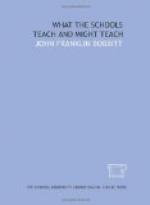The second condition enforcing a uniform course of study in certain subjects is the use of uniform examinations in those subjects. We would merely suggest here that it is possible to use supervisory examinations without making them uniform for all schools. Different types of school may well have different types of examination.
Different social classes often exist within the same school. Administrative limitations probably must prevent the use of more than one course of study in a single elementary school. But as the work of the grammar grades is departmentalized, and as junior high schools are developed, it will become possible to offer alternative courses in these grades. Those practically certain of going on to higher educational work requiring foreign languages and higher mathematics should probably be permitted to begin these studies by the sixth or seventh grade. On the other hand, those who are practically certain to drop out of school at the end of the grammar grades or junior high school should have full opportunities for applied science, applied design, practical mathematics, civics, hygiene, vocational studies, etc. When the necessary studies are once organized and departmental work introduced, it is not difficult to arrange for the necessary differentiation of courses in the same school.
Finally, courses of study should provide for children of differing natural ability. Extra materials and opportunities should be provided for children of large capacity; and abbreviated courses for those of less than normal ability. In departmentalized grammar grades and junior high schools this can be taken care of rather easily by permitting the brighter pupils to carry more studies than normal, and the backward ones a smaller number than normal. Under the present elementary school organization with classes so large and with so many things for the teachers to do, it is practically impossible to effect such desirable differentiations.
SUMMARY
1. The fundamental social point of view of this discussion of the courses of study of the Cleveland schools is that effective teaching is preparation for adult life through participation in the activities of life.
2. The schools of Cleveland devote far more time to reading than do those of the average city. In too large measure this time is employed in mastering the mechanics of reading and in the analytical study of the manner in which the words are combined in sentences and the sentences in paragraphs. The main object of the reading should be the mastery of the thought rather than the study of the construction. Through it the children should gain life-long habits of exploring, through reading, the great fields of history, industry, applied science, life in other lands, travel, invention, biography, and wholesome fiction. To this end the work should be made more extensive and less intensive. As an indispensable means toward this end the books should be supplied by the schools instead of being purchased by the parents.




